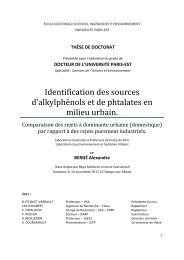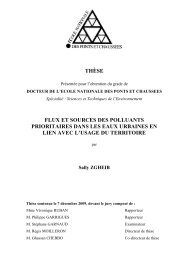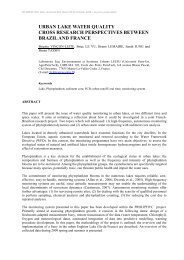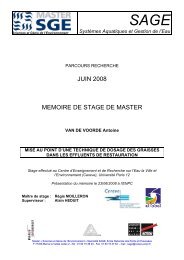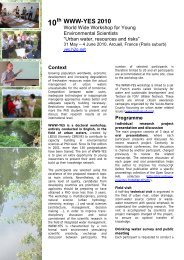View - ResearchGate
View - ResearchGate
View - ResearchGate
You also want an ePaper? Increase the reach of your titles
YUMPU automatically turns print PDFs into web optimized ePapers that Google loves.
treatment accounts for only 36.1% of collected flows, with very variable efficiency levels(actually removing less than 24% of total DBO generated); besides, invoice collection isestimated around 81% of total billed consumption and unaccounted-for water is calculated in42%, which renders a global efficiency under 50% (CNA 2006, 2007a). Sustainable provisionof water services is threatened simultaneously by the financial, administrative and technicalweaknesses of municipal operators and by the rapid reduction of reliable water sources, thedeterioration of watersheds – in 30 years, the number of overexploited aquifers has tripled,potentially affecting 60% of groundwater sources in the country, while 47.8% of surfacewaters are considered as polluted or heavily polluted in terms of their COD levels (CNA,2007a) –, the growth in conflicts between users, the reduction of subsidies and the growingcompetition for financial resources. It is expected that, in the year 2030, 53% of the populationwill live in 35 cities with more than 50 000 inhabitants, mostly concentrated in the central andnorthern parts of the country (CNA, 2007a) – where sources are becoming scarcer andconflicts more frequent; in the future, more than 100 million people would be affected if thepresent condition persists in the urban water supply sector. The need for setting up a properintegrated urban management model seems to be a difficult task but also a potential tool forsorting out from this complex situation.One research question that could be posed is why, under similar institutional environments, somany different institutional arrangements have emerged throughout the country. In somestates, as Guanajuato, water supply is under the jurisdiction of each of the 46 Municipalities; insome others, as Querétaro, the State authority operates water supply systems throughout itsterritory, with the exception of one city; in others, like Baja California, there is a Statedependentoperator in charge of the city of Tijuana – one of the best managed water supplysystems in Mexico – while in others, like Nuevo León, the inter-municipal operator of thecapital metropolis, Monterrey, is growingly taking part in the development of services in othercities in the State, including rural ones. Talking about private sector participation, the failure ofthis policy – in terms of its objectives of attracting investment capitals, extending services tothe poor and liberating public funds while improving efficiencies in concessioned systems(Castro, 2007) – could have been a matter of a failure from the part of regulating bodies, aconsequence of the difficulties for implementing new tariff structures or of the paralysis facingthe sharing of risks (Breuil & Nakhla, 2003), but a more detailed analysis could be worthy.Specifically, the very different nature of institutional environments from the countries whosemodels have inspired the private participation schemes from the 80’s, in terms of their stabilityand the relative simplicity of their operation should be analyzed – since those models aren’tprobably well suited to face problems like urban development lawlessness or the need to buildextensive infrastructure, circumstance which could perhaps explain the good performance ofprivatization schemes (such as in England) or leasing contracts (such as in France) in thosesettings. Disregarding the public or private nature of the capitals involved in the extension andthe operation of urban water systems, it is true that municipal operators, in spite of the reformsimplemented in the 90’s aiming to transform them into public enterprises, are now jammed ina system of overlapping relationships of normative, supporting, cooperative and subordinatingnature dealing with its federal, state and local counterparts. As Breuil (2004) describes it,public urban water supply is characterized by the absence of a formal contractual frameworkand thus of specific objectives, where self-control predominates and a strong politicalinterference remains in price setting. Moreover, if dissecting water supply and politics hasbeen seen as naïve (Schwartz & Schouten, 2007), due to “water sector realities” in developingcountries, from the figures and perspectives presented, the need for finding alternative waysfor improving governance structures and institutional settings seems well justified.Understanding the origin and dynamics of the institutional diversity in the Mexican watersector, both from the national context and from the local specificities, in particular for trying toidentify some clues or paths from the analysis of the institutional arrangements in place indifferent settings, seems to be instrumental for opening ways to the design of innovating publicpolicies in this sector. By its own nature, as well as because of the long-term questions raisedby the quest for integrated or sustainable management of urban systems, two kinds ofquestions can be posed. First: Is there a relationship between the evolution in the institutionalenvironment, the governance structures and the systems’ capacity to ensure a sustainableprovision of water services in the urban context? And second: Is there a place for strategyformulation and strategic management within such a complex setting as the one we have indeveloping countries? In other words, what have been the feasibility, the role and destiny ofstrategy formulation and implementation in this context? Would the implementation of astrategic performance management process help to improve learning about the issues linked tothe transformation of a governance model in sake for improving the system’s sustainability? Inthis paper, a research proposal is outlined for addressing these issues.THEORETICAL FRAMEWORK AND METHODSRationale and proposed methodologyThe primary aim of this research is to analyze the relationship between governance structuresand performance in the context of a set of Mexican urban water supply operators, specificallyfocusing on the role of information and strategic performance management processes andtools. In a first stage, a thorough revision of the origins and characteristics of a selected set ofurban water supply governance structures within the country would be undertaken. Then, sinceurban water supply is a long term subject, the actual and potential role of strategicmanagement processes – or, eventually, the absence or the obstacles for implementing suchkind of processes – would be studied. In a second phase, the implementation of tools forstrategic performance management – a strategic scorecard, dashboard or control panel,developed through a participatory and recursive process of selection of indicators, evaluationand feedback – is envisaged as a potential mean for exploring the main issues affectinggovernance in urban water supply, both from an environmental as from an internal institutionalapproach.New institutional economics is proposed as the basic theoretical framework for this research(Williamson, 1996; Powell & DiMaggio, 1991; Ménard, 2003), complemented with theexploration from a cognitive approach to contract theory (Girin, 1995) and strategicmanagement (Bouvier, 2004) and from stakeholder theory (Freeman, 1985). A specificapproach of intervention research is suggested, where the presence and eventually theimplementation of management tools is considered as a structuring and learning devicecapable of revealing unattended knowledge about “organizational operation, the piloting oftransformation and the exploration of new [courses of action]” (Moisdon, 1997; 2006). In thiscase, the eventual implementation of an adaptation of a Balanced Scorecard (Kaplan andNorton, 1992) or tableau de bord kind of management tool is being considered a priori as apotential pivot for a second phase of the field exploration; a specific process for theimplementation of a strategic performance management tool would be used to analyze thetransit towards a different governance model, in which an adequate consideration ofstakeholders’ criteria and priorities should be incorporated, as well as the proper sustainabledevelopment criteria.WWW-YES 2008, Paris 13 – 16 May 2008 119WWW-YES 2008, Paris 13 – 16 May 2008 120



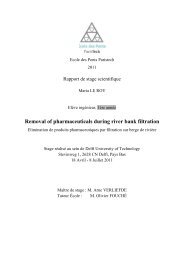
![[pastel-00730831, v1] Incidence des pratiques d'entretien ... - LEESU](https://img.yumpu.com/50938896/1/184x260/pastel-00730831-v1-incidence-des-pratiques-dentretien-leesu.jpg?quality=85)

